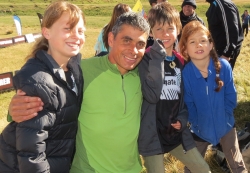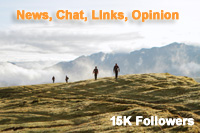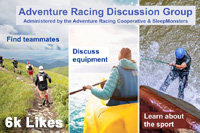Book Review; Nathan Fa'avae's Autobiography - Adventurer at Heart
Rob Howard / 23.12.2015

Nathan Fa’avae has been the dominant athlete in adventure racing in recent years and his keenly awaited autobiography doesn’t disappoint.
Yes, it’s a team sport and it’s Team Seagate who have been dominant, but Fa’avae has been the driving force, captain and spokesman for the team, which was built around him and financed on his connection with Seagate. And the current Seagate team and all their success are the second go around for Fa’avae, he’d already ‘retired’ in 2005 after a hugely successful racing career topped off by winning the World Champs on home soil in New Zealand (with Team Balance Vector).
Having witnessed many of his triumphs and disappointments around the world I was as keen to read ‘Adventurer at Heart’ as anyone, to find out more about the man whose amazing achievements I’d reported, and whose sound-bites I’d relayed.
In many ways his book reflects some of the characteristics seen in his team management. It’s very organised and well ordered, with even length chapters which start at the beginning and move chronologically though his life, with a couple of chapters thrown in at the end to discuss the state of AR and what might come next for him and his family. Quirkily all the chapter titles begin with ‘N’.
Parts of the book tell of his successes in business and you get the impression he’d write a good company report and staff review, and he wouldn’t beat about the bush if things were not going how he wanted either! He writes very directly.
That’s not to say it’s dry, far from it, it’s well written and given the life he’s lead it could never be dull. He says in the introduction part of the reason for writing was because his wife Jodie wanted the family to benefit from the financial opportunity it offered and that he looked on the book as a challenge to motivate his writing
His sense of humour is there at the outset as in the introduction he begins by describing winning the 2005 World Champs ahead of his ‘retirement’ and says the book is about how he reached that point … and what he did next!
His early adventure racing career followed a youth which veered towards the wrong side of the tracks, and he says his brother was always much better at sport than he was! His independence lead him outdoors much of the time and it was the outdoors which inspired him and gave him a sense of purpose through sport. This was initially in mountain biking where he felt the buzz of winning and trained intensively, though he did also run a sub 3 hour marathon as a teenager as well.
The book kicks up a gear describing his iconic first Coast to Coast performance, where as an 18 year old he burst onto the multisport scene in the highest profile race of all. He pretty much started out at the top, with the highest standards, but at that time with no experience or race savvy. He describes moving comfortably along with the leaders and wondering why they were going so slowly!
He was the leader on the first day of the 2 day event, much to his surprise and the media reception was a pivotal moment for him. “It taught me that anything is possible, and not to set limitations, just go out and give it everything and see what happens.” Remarkably he’d only just learnt to kayak and he finished 11th overall next day, but with typical determination he had qualified as a kayaking guide within a few years and there are many epic kayaking adventures described in the book.
After a successful time in bike racing, and 3 years as an Outward Bound instructor his first expedition race was the Southern Traverse in 1999, which the team won, but at the end of it he had his first experience of heart problems, which were to plague him through his racing career.
To some it may be a shock to read that, given what he’s achieved, but he raced for much of his career with Atrial Fibrillation which at times stopped him in his tracks. Sometimes he’d rest up, recover and go on to win. Over the years he’s had 3 operations for the condition and also suffered from regular shoulder dislocations, one of which caused his team to retire from the 2000 Raid Gauloises in Nepal and Tibet. He’s suffered frequently with altitude sickness too.
Despite this he went on to establish himself as a world class adventure racer in the next 5 years and achieve huge success, He says his first year as a pro racer paid off his mortgage and his timing was perfect as he hit the big time when the sport was at its hottest and richest. In the early 2000’s there were several races per year with 6 figure prize sums for the winners. In 2003 this included, Eco-Challenge, Raid Gauloises, Primal Quest, Mild Seven Outdoor Quest and even the shorter Balance Bar series in the U.S.A.
2001 was his first Eco-Challenge and another pivotal moment when he was in a state of near collapse at the finish and his Kiwi team lost the lead and the race right at the end to be the first Kiwi team defeated in a big race on home soil. That was painful, and he came back to win the following year in Fiji, now sponsored by Seagate. It was a performance he described as “the ultimate example in sport of an unrelenting desire to succeed and never give up.”
He’s not very polite about Eco-Challenge and the fact they never let the rules get in the way of a good story! There are some caustic comments peppered throughout the book; on Nike’s corporate philosophy, over complex training and diet plans, officious marshals and World Series management, but the most damning are reserved for the U.S. immigration officials who held and deported him. (Naturally he didn’t take that lying down and he subsequently got an apology and life-time visa!)
That’s a theme in the book – coming back from setbacks or problems, and coming back stronger. In the 2011 Tasmania World Champs Seagate lost after getting a 4 hour penalty when he left a spot tracker behind. It was a loss he was bitter about but the team were highly motivated for the following year in France and dominated the race. Then in 2013 in Costa Rica Seagate withdrew with foot infections when they felt they might have won, another loss they found hard to take and they came back to win convincingly again the following year in Ecuador.
That year the team planned a 10 day altitude acclimatisation trip before the race – which is not an option most teams could afford. One of the most jaw dropping things in the book is the level of financial support from Seagate and their founders for both the team and Fa’avae himself.
Another are the descriptions of the family trips with his wife Jodie and 3 children which are some of the most enjoyable parts of the book. To say they are adventurous is an understatement and at times they are hair-raising. The Fa’avae’s don’t really go in for modern P.C., protective parenting and if the younger Fa’avae’s take to adventure racing there is no doubt they’ll be ready for anything!
He describes his own adventures and some very narrow escapes too and the book is far from being all about racing, though it’s mostly about the adventurous way he lives his life. Parts of the text are very poignant, especially the time of his mother’s death in a car accident and also the descriptions of the times he was involved in events where racers died. One of these was at Primal Quest when Nigel Aylott died after a rock fall. The race continued and Seagate waited for Nike so they could swap seats into each other’s kayaks and finish all together as one team, a great act of sportsmanship to mark a tragic race.
One of the oddest parts of the book is the period of his first ‘retirement’ after 2005 when he seems to drift steadily back into top class racing. Where all his other choices seem well thought out he doesn’t ever really pinpoint a decision to return to racing, it just happened. Then Sophie Hart came on the scene as his protégé and Seagate came back in to sponsor the team again for another 5 years of world class racing.
It does make me wonder how well he’ll adjust to racing retirement now, though he’s already said he will compete in some races, but maybe not at the highest level or in World Championships. I do think it was a pity he chose to complete the book before the Seagate win this year in ARWC Pantanal though. That is another epic story and it would have been a fitting finish as 3 times world champion and captain of the first team ever to be world ranked no.1 with maximum possible points.
By the end of the book you realise just what an iconic and unique sportsman Fa’avae is, and there is far more to his story than I can comment on here. It’s an uplifting tale of a man successfully pursuing his dreams, sometimes against the odds, and without making any compromises.
‘Adventurer at Heart’ should be on every adventure racers bookshelf, and it’s probably the best training aid currently on the market – because you won’t read it without being inspired.
‘Adventurer at Heart’ is available in paperback with a 16 page colour photo section at NZ$39.99.
For more information and international orders see; http://www.pottonandburton.co.nz/store/books/nathan-fa-avae
You can find out more about Nathan Fa’avae and his coaching and event management businesses on his website at http://nathanfaavae.nz/#intro






 SleepMonsters
SleepMonsters



